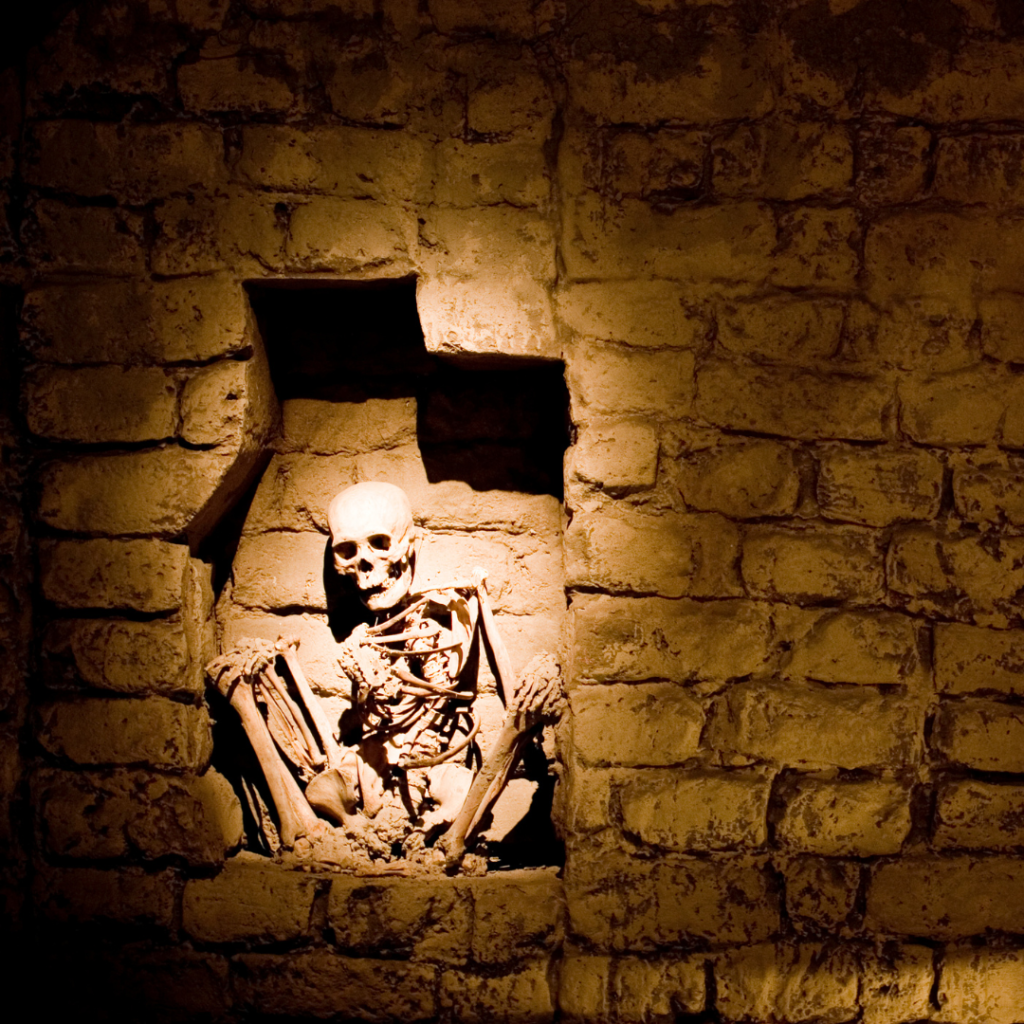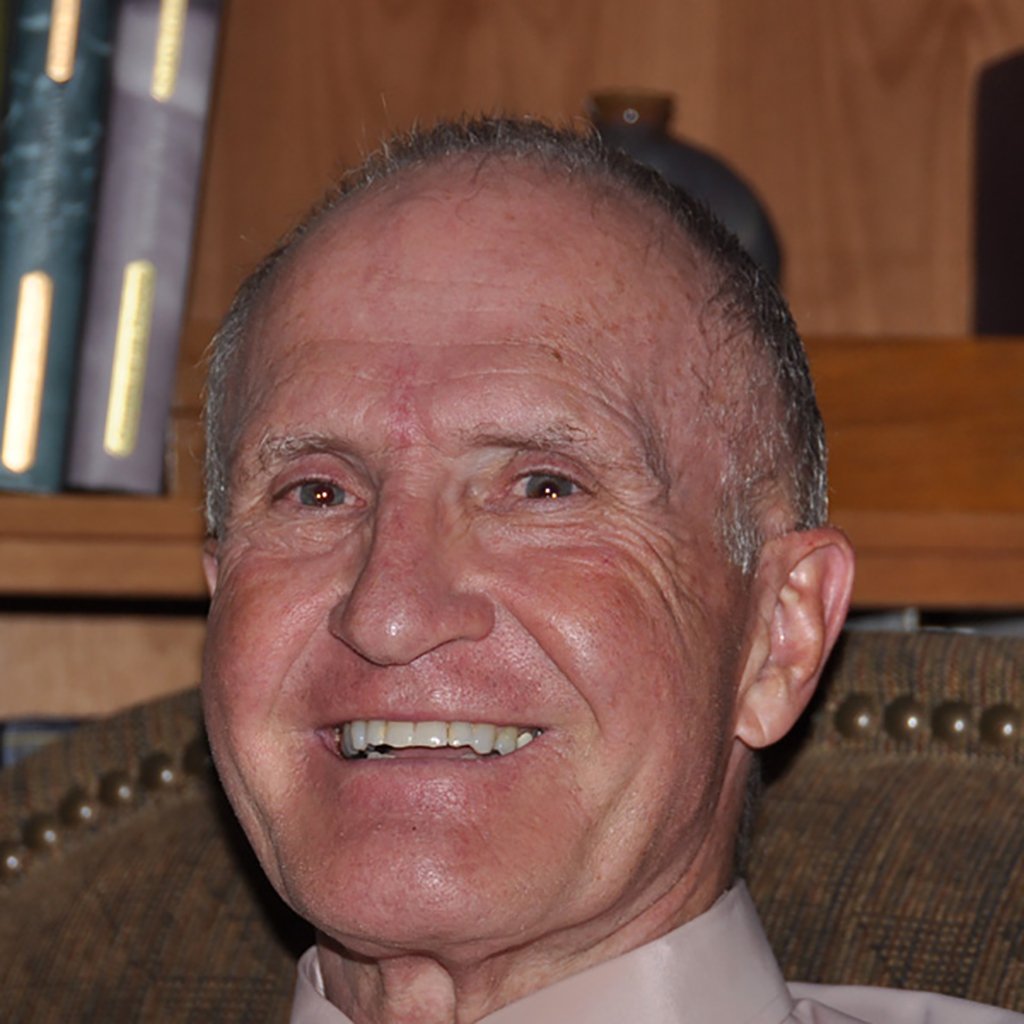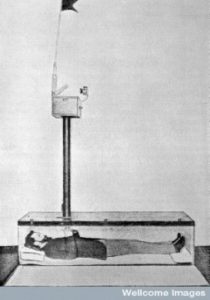
In the Victorian age, premature burial required very real preventative inventions. In the 19thcentury, this commonly took the form of elaborate coffin mechanisms. The second version of Premature Burial… included a handful of elaborate coffin mechanisms to assist the potentially nearly-dead. The first–by Russian Count Michel de Karnice-Karnick–was presented in 1897 following his description of personally witnessing a Belgian girl be buried alive. Tebb and Vollum’s description of de Karnice-Karnick’s invention is as follows:
“…it consists of a long tube, about three and a half inches’ diameter, and a hermetically-sealed box. The tube is fixed into an aperture in the coffin as soon as the latter is lowered into the grave. No gases can escape from the tomb into the outer air, as the metallic box into which the upper end of the tube enters cannot be opened from the outside.
On the chest of the supposed dead body is placed a glass ball, several inches in diameter, attached to a spring which communicates through the tube with an iron box above ground.
On the slightest movement of the chest’s wall, as in the act of marked breathing, or movement of the body, the glass ball releases a spring which causes the lid of the iron box to fly open immediately, thus admitting both air and light to the coffin. At the same time a flag rises perpendicularly about four feet above the ground, and a bell is set ringing which continues for about half an hour. In front of the box, an electric lamp burns which gives light after sunset to the coffin below. The tube acts as a speaking tube, and the voice of the inmate of the coffin, however feeble is intensified.”
In short, the invention was an elaborate jack-in-a-box system.
Although the mechanisms may sound bizarre to 21st century readers, the mechanisms of the coffin system were thoroughly tested and proved to be a great success when tested on the living. But… a short coming was found when tested on the dead. While the dead do not breathe, they do decompose. The glass ball was supposed to be activated by breathing, but it was equally as efficient at detecting the bloating and rotting of the dead. That proved fatal to the invention’s success. To avoid a run of unnecessary exhumations and cemetery flag-flying, use of the invention was strongly discouraged.
Simpler and further back in history and well before modern complicated coffin systems, earlier methods of prevention consisted of a simple cord attached to a bell, or similar method used to attract outside attention. Flags, ladders, and minor explosions, were all popularized, but most decided to do without the inclusion of a breathing tube, making them—including de Karnice-Karnick’s–all redundant.
In the 1820s, portable death chambers were popularized in Germany. Those chambers were constructed over open graves and were furnished with a bell and viewing window. If the bell was rung, the body could be immediately exhumed, meanwhile ‘watchmen’ could peer into the chamber to search for signs of decomposition, as an efficient precaution.
In 1829, another German–Dr. Johann Gottfried Taberger–invented a system of strings and bells attached to the body’s extremities. The drawback, like that of Karnice-Karnick’s, natural decomposition and shifting of the body frequently caused false positive results, rendering the bells, once again, inconsequential and another industry failed.
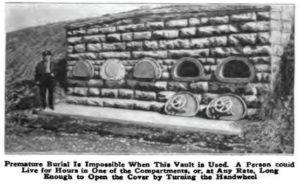
Patent No. 329,495 was granted on November 3, 1885 to Charles Sieler and Fredrerick Borntraeger for a “Burial-Casket”.
The invention provides for improvements in the important components of previous “burried alive” [sic] inventions. In this instance, motion of the body triggers a clockwork-driven fan (Fig. 6), which will force fresh breathable air into the coffin instead of a passive air pipe. The device also includes a battery-powered alarm (M). According to the patent, “When the hand is moved the exposed part of the wire will come in contact with the body, completing the circuit between the alarm and the ground to the body in the coffin,” the alarm will sound. There is also a spring-loaded rod (I), which will raise up carrying feathers or other signals. Additionally [sic], a tube (E) is positioned over the face of the burried body so that a lamp may be introduced down the tube and “a person looking down through the tube can see the face of the body in the coffin.”
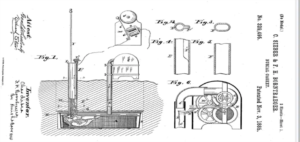
Several other inventions–including one as late as 1995–that required an intercom system, were patented, but ultimately proved pointless. There appear to be no official records of anyone ever being saved from a safety coffin and the western popularization of embalming rendered any chance of post-death survival ultimately impossible. Cremation or Aquamation and other “Green” methods carry much the same certainty.
Still, the fear remains, especially in popular culture. Six television series make up The Walking Dead franchise: The Walking Dead, Fear the Walking Dead, World Beyond, Tales of the Walking Dead, Dead City, and Daryl Dixon. All series-in total-amount to 320 episodes across 24 seasons of television. There are also numerous Walking Dead franchise offshoots–an American zombie apocalypse media and shared universe with movies and comic books set in the same fictional universe. The very creative franchise has—in addition–developed crossover plot elements, settings, and characters, that span five live-action television series, three additional live-action television series in various stages of production, as well as eight live-action web series that tie into the first two television series.
Zombies are ?fictional creatures usually portrayed as reanimated corpses or virally infected human beings. They are commonly portrayed as anthropophagous in nature—labelling them as cannibals would imply zombies are still members of the human species, according to expert opinions. Although most zombie films fall into the horror genre, some cross over into other genres: comedy, science fiction, thriller, even romance. Be sure–say the experts–zombies are distinct from ghosts, ghouls, mummies, Franken-stein’s monster, and even vampires, which comes as a surprise to ardent students of the genre such as the present author.
Mind you, there remain on the planet considerable numbers of people who believe firmly in zombies and a host of other forms of the walking dead, that the earth is flat, that vaccinations are the work of the devil, the Deep State, and liberals—according to Q Anon [On Christmas Day, Steven Brandenburg–a Milwaukee-area pharmacist–attempted to destroy more than 500 doses of coronavirus vaccine; because, he admitted, he feared the Moderna drug would “alter the recipient’s DNA”]. Anti-vax conspiracy theories are neither exclusive to COVID-19 vaccines nor new. In the 19th century, the smallpox vaccination was met with claims that it was a government measure to curb personal freedoms; would cause further illness; and that it was introduced to increase profits for those in the medical profession.
And bear in mind other associated ghosties, ghoulies, and three legged things that go bump in the night.
Just saying.

